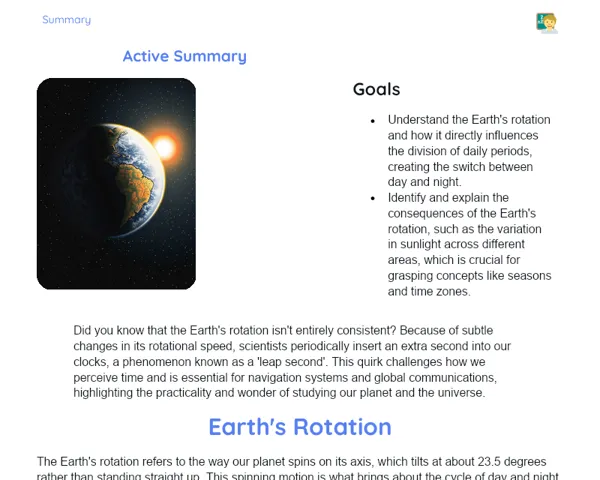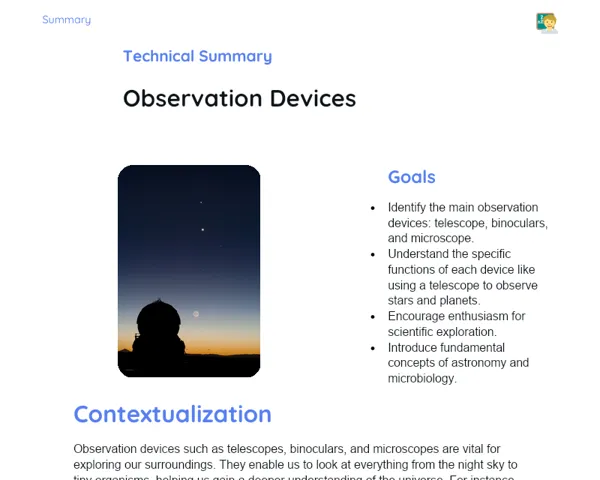Summary Tradisional | Main Phases of the Moon
Contextualization
The Moon, our natural satellite, goes through different phases over a cycle of about 29.5 days. These changes in the Moon's appearance, as seen from Earth, are known as lunar phases. The main phases include the New Moon, Waxing Crescent, Full Moon, and Waning Crescent. Each of these phases results from the relative positions of the Earth, the Moon, and the Sun, and how sunlight illuminates the Moon during its journey in orbit.
Understanding the phases of the Moon is important, as they not only influence natural events like tides but have also historically been used to create calendars and schedule human activities. Various ancient civilisations, like the Egyptians and Mayans, relied on the lunar cycle to determine planting and harvesting times. In our daily lives, observing the Moon's phases can help connect us more closely to the natural rhythms of our planet and the wider universe.
To Remember!
Lunar Cycle
The lunar cycle lasts around 29.5 days and describes the period the Moon takes to go through all its phases and return to the New Moon. This cycle is due to the Moon's orbit around the Earth, during which different portions of the Moon are illuminated by the Sun and are visible from us here on Earth. People have observed and recorded the regularity of this cycle for thousands of years, leading to the development of lunar-based calendars.
Because the lunar cycle is so predictable and regular, many cultures throughout history have used it for planning agricultural activities, religious festivals, and other significant events.
Understanding the lunar cycle is also key for those interested in astronomy and space exploration. For example, it affects the lighting conditions for landing sites in lunar missions and can impact the visibility of other celestial bodies during astronomical observations.
-
The lunar cycle lasts around 29.5 days.
-
The Moon's phases are due to its orbit around the Earth.
-
The lunar cycle is predictable and follows a regular pattern.
New Moon Phase
The New Moon happens when the Moon is caught between the Earth and the Sun, with the illuminated side facing the Sun and the dark side facing us. During this phase, the Moon is nearly invisible to the naked eye, as sunlight doesn’t shine on the part of the Moon we can see from Earth.
During the New Moon, the Moon and the Sun are on the same side of the sky, which can lead to a perfect alignment called a solar eclipse when the Moon obscures the Sun's light. However, solar eclipses are rare occurrences, as the Moon's orbit is tilted in relation to the Earth's orbit.
The New Moon signals the start of the lunar cycle and is followed by the Waxing Crescent phase. This stage is often linked to new beginnings and renewal in many cultures and spiritual practices.
-
The New Moon occurs when the Moon sits between the Earth and the Sun.
-
The illuminated part of the Moon faces the Sun, making it nearly invisible from Earth.
-
This phase can lead to a solar eclipse.
Waxing Crescent Phase
The Waxing Crescent happens shortly after the New Moon, when the Moon starts to shift out of its position between the Earth and the Sun. During this phase, a small wedge of the Moon begins to catch sunlight, forming a visible crescent in the night sky.
As the days go by, the lit section of the Moon grows larger and becomes more noticeable. This phase is often called a concave crescent or young crescent. The Waxing Crescent is a time of development and symbolizes growth and progress.
This phase can be seen early in the evening, just after sunset, and its position in the sky changes each night, moving further west as the lunar cycle progresses.
-
The Waxing Crescent phase follows the New Moon.
-
A small portion of the Moon begins to be illuminated, creating a crescent shape.
-
The illuminated part increases gradually as days go by.
Full Moon Phase
The Full Moon occurs when the Earth is positioned between the Moon and the Sun, allowing the entire side of the Moon facing us to be lit up. During this phase, the Moon appears as a bright, complete circle in the night sky.
The Full Moon is the brightest phase and is easy to spot with the naked eye. This event typically occurs about at the halfway point of the lunar cycle, around 14-15 days after the New Moon. The Full Moon has been wrapped in various myths and legends over the centuries, symbolising fullness, power, and change.
Lunar eclipses can also happen during the Full Moon when the Earth casts its shadow on the Moon. These eclipses are visible from large areas, giving us a fascinating glimpse into our solar system's dynamics.
-
The Full Moon occurs when the Earth is between the Moon and the Sun.
-
The entire side of the Moon facing Earth is illuminated.
-
It's the brightest phase, occurring roughly at the midpoint of the lunar cycle.
Waning Crescent Phase
The Waning Crescent follows the Full Moon, when the lit portion of the Moon starts to shrink. During this phase, the Moon appears to decrease in size each night, forming an inverted crescent shape in the sky.
This stage, referred to as convex waning or old waning, marks a time for introspection and reflection. The Waning Crescent can be seen late at night and early in the morning before dawn.
The decreasing brightness of the Moon during this phase creates perfect conditions for stargazing and observing other celestial objects, as there's less light pollution in the night sky. The Waning Crescent brings the lunar cycle to a close, leading back to the New Moon and restarting the cycle.
-
The Waning Crescent occurs after the Full Moon.
-
The lit portion of the Moon begins to shrink, forming an inverted crescent.
-
The Waning Crescent can be spotted late at night and early in the morning.
Key Terms
-
Lunar Cycle: The cycle of roughly 29.5 days during which the Moon passes through all its phases.
-
New Moon: The phase when the Moon is positioned between the Earth and the Sun, with its illuminated side facing the Sun.
-
Waxing Crescent: The phase following the New Moon when the illuminated segment of the Moon begins to grow.
-
Full Moon: The phase when the whole side of the Moon facing Earth is lit up.
-
Waning Crescent: The phase after the Full Moon when the illuminated part of the Moon begins to shrink.
Important Conclusions
The phases of the Moon present a captivating astronomical phenomenon that happens in a consistent cycle of approximately 29.5 days. Throughout this cycle, the Moon moves through distinct stages: New Moon, Waxing Crescent, Full Moon, and Waning Crescent, each with its own unique features and visibility. Grasping these phases enhances our appreciation of the beauty of the night sky while also helping us understand the Moon's effects on natural occurrences like tides and its historical role in developing calendars.
Understanding the phases of the Moon also links us to ancient cultures that relied on this lunar cycle to plan their agricultural practices and spiritual festivals. This historical and cultural perspective enriches our knowledge and allows us to view the Moon in the context of its significance for humanity across the ages.
Finally, observing the Moon's phases serves as an excellent introduction to astronomy and can spark a deeper curiosity to learn more about the universe. The Moon not only lights up our nights but also offers a window to a better understanding of our place within the cosmos. We encourage ongoing study to deepen this awareness and further embrace the mysteries of space.
Study Tips
-
Regularly observe the Moon and keep a lunar diary to track its phases, which will help with understanding the cycle and identifying each phase.
-
Read books and articles on astronomy that discuss the Moon and other celestial bodies. Reliable sources are key for deeper learning.
-
Consider using astronomy apps that show the Moon's current position and phase and provide additional info about the lunar cycle and other space phenomena.



